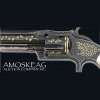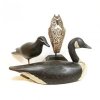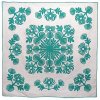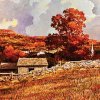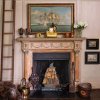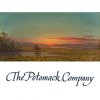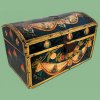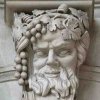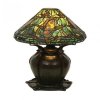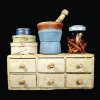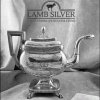Few Fireworks but One Rarity Discovered at Americana Auction
March 2nd, 2014
|
“Paul Revere, patriot, silversmith, engraver, and artist?” That was the question some viewers asked auctioneer Steven Fletcher prior to the sale, he said. He told us that he answered them with, “Of course he was an artist. How do you think he laid out the designs on the many pieces of silver he engraved, or on printing plates?” The 6½" x 5" watercolor portrait is inscribed “Major John Pitcairn.” The Massachusetts dealer and researcher who bought the portrait for $39,975 has concluded it’s not Pitcairn. See the main story for more.
This 25" x 36" oil on canvas portrait by William Gay Yorke depicts the American ship Weston Merritt off the coast of Liverpool. Executed in January 1862, the painting brought $28,290.
This molded copper standing stag weathervane, 31" high x 21½" long, brought $19,680, the highest price of the ten vanes offered.
Here is, reportedly, the artist himself, painted in the mid-1840s. James Sanford Ellsworth is the signature on the back of the backing paper; sight dimensions are 3¼" x 2¾"; and the price, $8610, was over ten times the $800 high estimate, which says a lot about how valuable a self-portrait of an artist can be.
There were 69 lots from the estate of Peter Rosenberg, a well-respected dealer of Chinese export porcelain, and this was the highest-priced lot. The pair of 14 7/8" high garniture vases with covers, decorated in the Mandarin palette with painted panel borders in underglaze blue, brought $11,685.
There was a comfortable aura to this portrait of a farmhouse, a 22" x 27" oil on canvas by Massachusetts artist George Frank Higgins (1850-after 1884). The light suggests that it was a midmorning or midafternoon scene, and the catalog says there are four people in the scene. We’ve blown up the photo to its limit and think we’ve found them. The woman who is walking by in the road has a child beside her; there’s a boy walking along the fence at far right; and someone is sitting just inside the open downstairs window, perhaps reading a paper or a book. The painting brought $4920.
The surface of this highboy has been a bit over stripped, but there’s no question that the wood is tiger maple (“Even a blind man could tell that,” one viewer said). Close your eyes and run your fingertips horizontally across any drawer front, and the prominent tigering is very evident. The height is 68", the width of lower case is 39¼", and it sold for $7995.
An offering from the on-line sale that closed the day after the live auction, this 20" high Renaissance Revival piano bench with gilt and painted turnings and a sheet music well under the upholstered seat sold for $1476 (est. $200/250).
From the on-line sale that ended the day after the live sale closed, this 21" high tin and wire birdcage in the form of the U.S. Capitol brought $2520 (est. $700/900). In red, white, and blue paint (most of it remaining) with conical tin shields above the glass food and water holders, a flag flying above the cupola, and an eagle holding a shield to its breast on the tympanum—the whole building surrounded by a fence—is this not the ultimate patriotic birdcage? |
Skinner, Inc., Boston, Massachusetts
Photos courtesy Skinner, Inc.
There was quite a difference between Skinner’s previous American furniture and decorative arts auction in Boston, held October 27, 2013, and the one held on Sunday, March 2, 2014.
To begin with, there were several events competing for dealers’ participation at the October sale, resulting in a low turnout at Skinner’s Park Plaza salesroom, but the rarity of the offerings drew a huge number of absentee and phone bids, resulting in truly spectacular prices. There was a great Seymour secretary that brought a super strong $120,000 from Massachusetts dealer Clark Pearce; a circa 1780 pear-shaped silver cann (beaker), made and signed by Paul Revere, that brought $120,000 from Portsmouth, New Hampshire, dealer Jonathan Trace; and an oil on canvas folk art portrait by Sturtevant J. Hamblen that went at $252,000 to New York City dealer Leigh Keno (through a phone intermediary). The entire October 2013 American furniture and decorative arts sale brought a whopping total of $2,207,626 (all prices include the buyer’s premium).
Now we skip forward to the March 2 American furniture and decorative arts sale. It began like the earlier one, with just under 32 people in the second-floor gallery off Boston Common; the body count rose steadily throughout the sale until midafternoon, then it dropped just as steadily. The money numbers were where the differences showed up.
The March 2014 cataloged auction realized $970,593, and the February 24 through March 3 on-line Americana sale that closed a day after the catalog sale added $199,684 to the total. Together, they brought in $1,170,277, just over half of what the 2013 sale garnered.
There were some very good offerings in several different categories, but the gems that ignite bidding battles and end in numbers that are way over estimates were lacking. The higest price honors from this sale were shared by two lots.
First came a 6½" x 5" framed watercolor portrait of a British officer on horseback, signed “P. Revere del.” and identified with the inscription “Major John Pitcairn.” The man in the audience who bought the portrait for $39,975 was Christopher Bryant, a dealer and researcher of historical paintings and objects. After buying the portrait, Bryant investigated the background, the connection to Revere, and the subject of the portrait.
Major John Pitcairn was a Scottish-born member of Great Britain’s Royal Marines and as such was sent to North America in 1774 by King George III to put an end to the uprising by the American revolutionary forces. He was billeted in the Boston area where Revere lived and became friendly with several Bostonians during his yearlong residence there.
Bryant’s research leads him to believe the subject is not Major John Pitcairn. “While the signed drawing by Revere is titled as Major John Pitcairn, commander of the British Marines at Lexington and Concord, I recognized that the uniform as drawn was that of a British General, and not that of a Marine,” Bryant wrote in an e-mail. “It had evidently been colored as a Marine, however, and the coloring was clearly original and done soon after it was drawn.
“I then realized that the face, as drawn by Revere, was clearly that of General Thomas Gage, who of course ordered the raid on Concord and Lexington.
“Further research revealed that this drawing first appeared at a 1921 auction of the estate of Duncan Phyfe’s grandson, with another signed Revere drawing of the same size and presentation, of one of the bridges at Lexington and Concord. Revere (or his protégé Callendar) provided all of the engraved illustrations for a patriot-oriented monthly magazine published in Boston in 1774-75 called the Royal American Magazine.
“Revere provided two illustrations for each monthly issue, and the last issue published was March 1775. A review of Revere’s engravings for the magazine reveals that he evidently provided the original designs and drawings for many and that he had some talent as an original artist, though none of his original sketches were previously known to have survived. The two Revere drawings from the Phyfe estate are exactly the same size as all of Revere’s engravings for the Royal American Magazine.
“The sequence of events became clear—Revere had drawn a portrait of General Gage, very much the man of the moment in Boston March / April 1775. The events on the 19th April 1775 at Lexington and Concord then appear to have perhaps literally stopped the press, and obviously became the lead story. As a more relevant image was immediately required, the drawing of Gage was simply repurposed as Pitcairn, colored and titled accordingly.
“There are several other instances of Revere reusing portraits of other people for his engravings of named individuals, so this was evidently an accepted practice at the time. The confluence of all of the circumstances evident in this painting reveals the progression of events as they unfolded at the very time and place of the outbreak of the American Revolution. It is truly extraordinary that in this drawing Paul Revere, as one of the key participants in these events on the side of the patriots, is recording and depicting at once essentially the two key figures on the British side, in what at the time was a form of news reporting and political propaganda.”
The Revere drawing will be featured in an exhibition at the Concord (Massachusetts) Museum, The Shot Heard Round the World: April 19, 1775, which will run from April 18 to September 21.
The other lot tying for top price honors at $39,975 was a fine set of 12 Federal shield-back mahogany dining chairs of New York City origin, possibly made by either Thomas Burling or Robert Carter. Two of the set are armchairs, and all had finely carved reed and fish-scale splats above a petal-carved lunette. A full set of 12 is rare, and this group appears to have been a well-bought lot at just under $40,000.
There were a large number of Chinese export porcelain lots from the estate of Peter Rosenberg in the auction. Nearly all brought above-estimate prices, sometimes as much as 400% above estimates. As near as we could figure, the porcelain offerings brought just under $100,000 (hammer).
“We have a lot of furniture in this sale,” auctioneer and department head Steve Fletcher conceded before the sale. “We tried to keep the estimates down, though,” he added.
For a 392-lot sale, the number of furniture lots didn’t appear to be excessive. There were six tall clocks, eight highboys, two tall chests, four slant-lid desks, and two settees or benches. One of the latter was a ten-legged example of the Windsor type; it had been somewhat heavily restored and brought only $2214.
Only two of the eight highboys managed to sell over the $10,000 mark. The best of the group was a Queen Anne walnut bonnet-top that had some restoration but still presented a striking appearance, having centered fans on both sections and carved stop-fluting on the side columns of both the top and bottom sections, with those on the top section topped with triple acanthus-carved capitals. Possibly by Portsmouth, New Hampshire, maker Joseph Davis, it sold to a phone bidder for $14,760.
Bidders, however, were a bit hesitant to bet the farm on a pair of well-executed folk portraits of David and Rhoda Richmond Aikens of Barnard, Vermont, possibly the work of painter Amanda Powers, who is thought to be the sister of the better-known Asahel. A condition issue may have turned some of them off.
The portraits were on wooden
panels that had bowed so severely, they almost resembled the 19th-century quarter-round, convex advertising signs that were once mounted on the exterior columns or corners of drug and dry-goods stores. That amount of bowing usually results in cracking, and the portrait of Rhoda had a crack from the top of the panel down to her left eye.
Skinner had sold a portrait of Rollin Richmond (the brother of the above Rhoda) in 2001 for $57,500. The best the pair could do here was $8610, just cracking the $8000/12,000 estimate.
Among the other art offerings were four pairs and two single miniature portraits attributed to James Sanford Ellsworth. All the pairs went to phone bidders. Two of the pairs brought $6765 each from separate phone bidders; one of the buyers of a previous pair took another pair for $3444; and the remaining pair brought $3198. A single portrait of a woman in a bonnet brought $1046, but the winner of the Ellsworth sextet was an unusual half-length frontal view miniature self-portrait of the artist. Executed on thick paper cut to a shield shape at top, then mounted on embossed valentine paper that had wrinkled around the perimeter inside the rectangular frame, it is an unusual miniature watercolor portrait of an American artist, and it appeared to be worth every cent of the $8610 it brought.
Also up for bid was an attractive gouache on paper cityscape, A North View of the City of Washington, unsigned but confidently attributed to the British-born artist George Beck (1748-1812). Beck and his wife moved in 1795 to the U.S., where he first painted landscapes around Baltimore. He then moved westward and did various paintings of the Potomac River (two of which were bought by George Washington and hung at Mount Vernon), before ultimately settling in Lexington, Kentucky, where he died. Skinner gave the 14½" x 19½" view a $3000/5000 estimate, but bidders liked it better than that. When the hammer fell, someone owned it for $13,530.
Another painting didn’t fare quite as well. The 27½" diameter oil on canvas portrait of Louisa Catharine Carroll and child in an impressive gilded composition circular frame was attributed to Thomas Sully. Louisa was the granddaughter of Charles Carroll III, a delegate to the Continental Congress, a signer of the Declaration of Independence, and first senator from Maryland, and the portrait had been exhibited in 1975 at the Baltimore Museum of Art, but those honorable connections could lift the portrait only to $8610 (est. $8000/12,000).
There were several watercolor theorem and fraktur paintings that carried labels identifying them as having once been the property of the American Folk Art Gallery in New York City, which holds an important place in American art history. In 1926 Edith Gregor Halpert opened the Downtown Gallery, which featured contemporary American art, and in 1931, with the help of her partners Berthe Kroll Goldsmith and Edgar Holger Cahill, she established the American Folk Art Gallery upstairs.
The location of the galleries changed over the years, but Halpert was the moving power behind them in all their identities. She collected modern art, folk art, and all art that attracted her, and she is credited with introducing Abby Aldrich Rockefeller to these works from America’s past.
 Edith Halpert died in 1970. Sotheby Parke Bernet sold her collection on November 14 and 15, 1973, with the main attraction being a 16¾" x 20" version of The Peaceable Kingdom by Edward Hicks. Themidsize painting (Ralph Esmerian’s version of the iconic oil was 26" x 29 3/8") sold for $65,000, a figure comparable to $342,105 today.
Edith Halpert died in 1970. Sotheby Parke Bernet sold her collection on November 14 and 15, 1973, with the main attraction being a 16¾" x 20" version of The Peaceable Kingdom by Edward Hicks. Themidsize painting (Ralph Esmerian’s version of the iconic oil was 26" x 29 3/8") sold for $65,000, a figure comparable to $342,105 today.
The highest-priced Skinner lot with an American Folk Art Gallery provenance was the 12" x 7½" ink and watercolor framed fraktur (birth certificate) for John Hirem Gentsem in 1844, painted by Rev. Henry Young (1792-1861). It depicted the young parents standing with a tripod-base table between them. Estimated at $4000/6000, it brought $15,990.
Furniture may be going for a song, but good folk art demands a standing chorus and full orchestra.
For more information, contact Skinner at (617) 350-5400 (Boston) or (508) 970-3000 (Marlborough); Web site (www.skinnerinc.com).
Originally published in the May 2014 issue of Maine Antique Digest. © 2014 Maine Antique Digest
